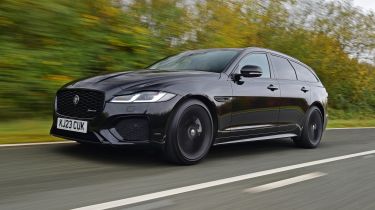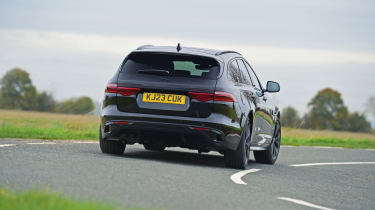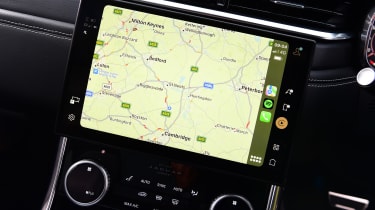New Jaguar XF Sportbrake 2024 review: big estate with value boost
Jaguar's XF Sportbrake may be 8 years old but it just got a whole lot cheaper!

Verdict
Jaguar’s pricing of the XF Sportbrake keeps it competitive in 2023. Traditional executive rivals have moved on, but the Jag is a comfortable if not stand-out option in the premium estate segment.
There’s no getting away from the fact the current Jaguar XF is now eight years old. The Ian Callum-designed exterior wasn’t altered during the last facelift in 2021 but that’s no real problem because this is a car that’s aged gracefully. It remains one of the sleekest shapes in estate land, to our eyes. Instead, Jaguar’s efforts were aimed at updating the interior and giving its executive car mild-hybrid power but since then not much has changed. Not much on the car, that is.
The XF has actually found itself in new territory for 2024. Its immediate rivals at the point of introduction back in 2015, such as the BMW 5 Series, Mercedes E-Class and Audi A6 have since received all-new replacements. Rather than continue to battle on as an alternative to these high-tech German executives, Jaguar has rather sensibly decided to lower expectations and, crucially, prices. This policy places the XF and XF Sportbrake estate up against smaller models in the compact executive class.
The pricing of the XF Sportbrake now not only undercuts its original rivals but that of their smaller counterparts, BMW 3 Series Touring, Mercedes C-Class Estate and Audi A4 Avant, as well. We’ve taken the chance to get reacquainted with the XF Sportbrake here to see if Jaguar has sold its ageing executive short or turned it into a bargain buy.
Used - available now

2020 MINI
5-Door Hatch
42,441 milesAutomaticPetrol2.0L
Cash £17,050
2022 Toyota
Corolla Touring Sports
27,231 milesAutomaticPetrol1.8L
Cash £17,000
2021 Volkswagen
Touran
32,705 milesAutomaticDiesel2.0L
Cash £18,200
2018 SEAT
Ibiza
62,864 milesManualPetrol1.0L
Cash £8,900We’re testing the Jaguar XF Sportbrake in the R-Dynamic trim which pretty much blacks out all of the exterior brightwork. Along with the monochromatic exterior, the interior gets as standard: 16-way adjustable heated and ventilated seats, ‘Satin Charcoal Ash’ wood trim, an electrically adjustable steering column and a sound system from Meridian. Adding to the overall premium air of the XF’s cabin are illuminated metal tread plates, metal pedals and a lovely set of chrome gearshift paddles behind the steering wheel.
The interior has been updated where it really matters throughout the XF’s life. The overall ergonomics were always strong with plenty of room front and rear and lots of handy storage spots. The introduction of an 11.4-inch touchscreen back in 2021 really spruces up the dash and the climate controls beneath utilise a small screen that’s always on hand. The physical dials are a little counterintuitive with the push/pull function swapping between fan speed and seat heating.
As for the Pivi Pro infotainment itself, it’s super slick and has a quality design to it. We switched between its menus a lot and found barely any lag on the system. The physical controls on the steering wheel are also a breath of fresh air when you compare them to the touch-sensitive controls other premium marques are offering in their latest models.
The fit and finish of the XF is still impressive and there’s plenty of soft-touch leather and chrome around. The dark wood finish on the dash does make the cabin a little dreary though.
Our car was fitted with a number of optional extras, too, some of which we’d avoid. The £505 soft-close doors seem excessive and the £50 gesture-control for the roof blind will have you waving your hand around wildly (there’s a physical button anyway). If you’re a fan of head-up displays, the XF’s £830 system is pretty good - not too intrusive in its display but still offering key information prominently. Given the lack of colour in the cabin on our car, the £1,125 panoramic roof feels well worth it.
This XF Sportbrake is powered by the 2.0-litre mild-hybrid four-cylinder diesel engine. It has 201bhp and 430Nm of torque, which sounds plenty but at the XF’s size and 1,870kg kerb weight means you wouldn’t want any less than this.
The 0-60mph time of 7.3 seconds is respectable and certainly enough to keep up with diesel versions of the BMW 3 Series Touring and Mercedes C-Class Estate but on the move the eight-speed automatic just slightly lets the side down. With the driving mode set to Eco or Standard the gear shifts are quite relaxed and around town the XF can feel a little lethargic, there’s not as much immediate input from the electrical system as we’d like.
You’re unlikely to take the XF Sportbrake in this diesel form for a spirited drive for the sake of it, but if you do decide to explore the big Jaguar’s dynamic capabilities you’ll be pretty impressed. The XF’s driveability was its biggest plus-point when it first launched and it still stands out even among rivals in the smaller executive class.
There’s lots of grip, not much body roll and the steering is responsive enough - without being all that engaging. Power from the diesel engine heads to the rear wheels (though an all-wheel drive version is available) and while it’s rare to notice this rear-driven nature, the XF Sportbrake is nicely balanced in the bends.
The diesel engine is punchy but the rev range feels short (because it is) and you’re reliant on snappy gear changes to really make progress, which sometimes don’t arrive as quickly as anticipated. You can override the automatic with the manual shift paddles and it delivers a little more engagement and predictability, but it’s still not super responsive.
As you’d expect of a big Jaguar, refinement is one of the XF’s best qualities - but this isn’t so obvious with this powertrain. The diesel engine is noticeable around town but settles down on the motorway - where the XF does its best work. We expect that the brief interruptions to the otherwise composed ride were caused by our car’s 20-inch wheels. These are standard on the HSE where the lower SE gets 19-inch rims. The suspension seems to soak up bigger bumps and ruts in the road, but churned-up surfaces highlight tyre roar. The standard-fit self-levelling rear suspension is a nice addition.
We noticed during our test that the XF Sportbrake would easily achieve the quoted 50.7mpg figure on a long motorway run. While this is pretty average for the class of mid-size executive estates, a 320d Touring will return a figure in the mid-50s and a C-Class Estate diesel even higher. On short runs we found fuel economy dropped to around 43mpg on the Jaguar.
This side of a Skoda Superb Estate, not much can compete with the Sportbrake’s practicality. There’s a load of rear passenger room combined with a 563-litre boot which is less than you get in the Skoda, but comfortably more than a 3 Series Touring, C-Class Estate and A4 Avant. The electric boot lid of the XF Sportbrake is also helpful.
We mentioned earlier on about the repositioning of the XF Sportbrake to a compact executive class level in terms of pricing and at £43,005 for this R-Dynamic HSE without options and with an even cheaper R-Dynamic SE available at £40,810, this Jaguar estate has found a new value-driven appeal.
| Model: | Jaguar XF Sportbrake R-Dynamic HSE |
| Price: | £43,005 (£47,590 as tested) |
| Engine: | 2.0-litre, four-cylinder diesel MHEV |
| Transmission: | Eight-speed automatic |
| Power/torque: | 201bhp/430Nm |
| 0-60mph: | 7.3 seconds |
| Top speed: | 143mph |
| Efficiency/emissions: | 50.7mpg/146g/km |
| On sale: | Now |










